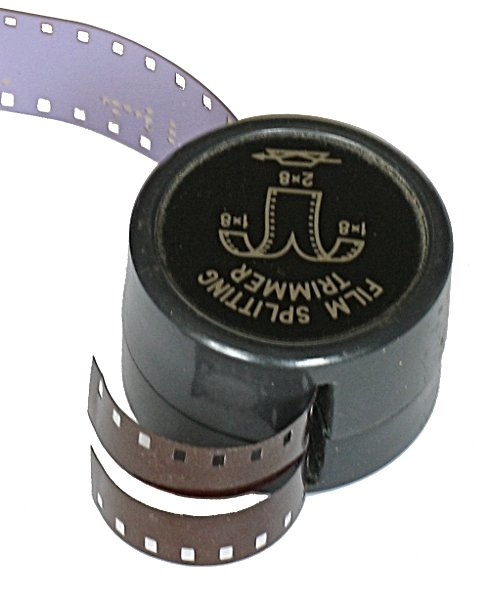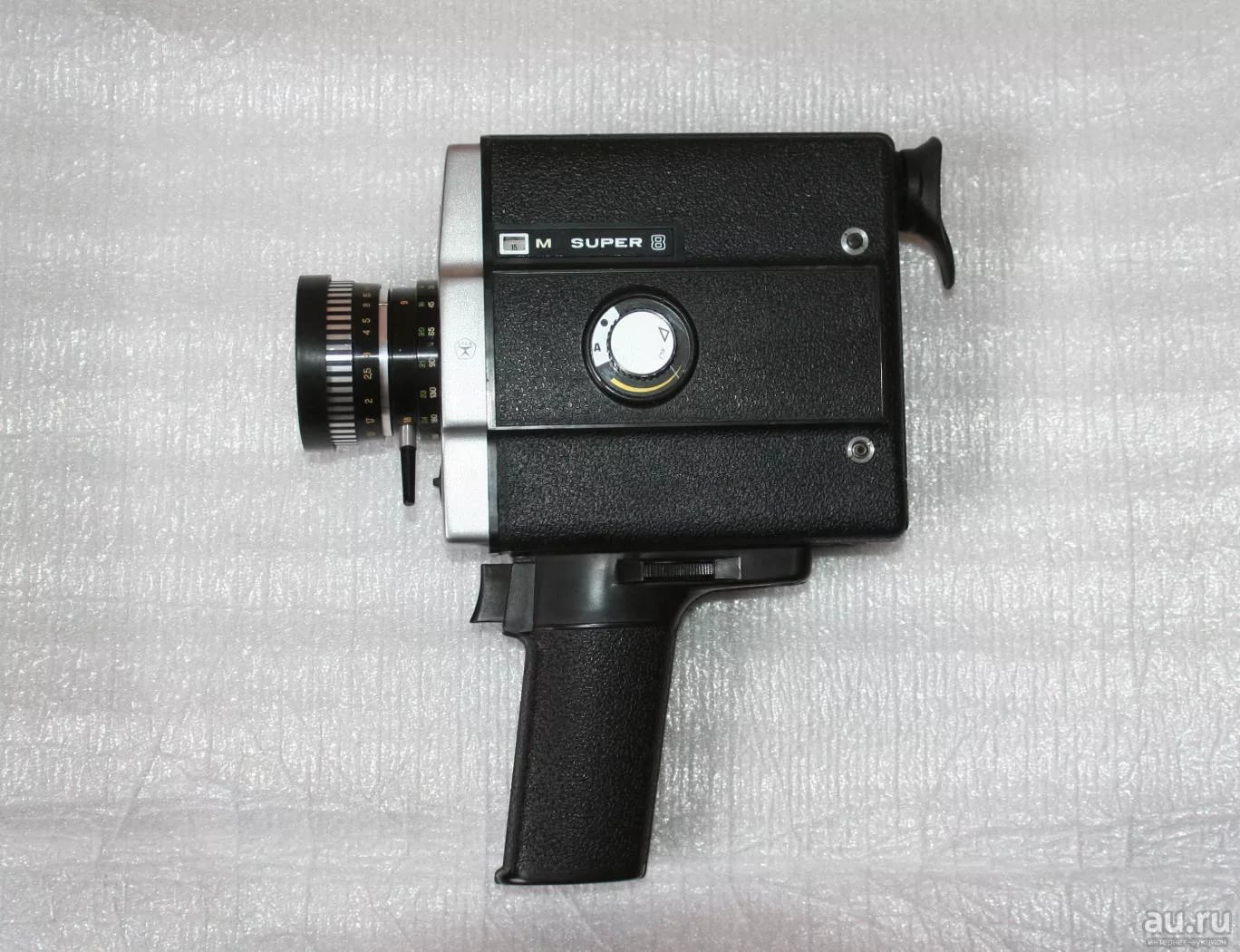Telekino
I was born in 1981, at that time there were already quite modern cameras such as Zenith, FED, which could make excellent black and white photographs on 35 mm film. But the video was quite expensive and for the majority of the population was available in 8mm or super-8 format. This technology speaks for itself.
The width of the film is only 8 millimeters, the frame size is 4.4 × 3.25 mm, the progenitor of this format was a film 16 mm wide. Initially, because of the high cost of film, a solution was invented in which shooting on 16 mm film was done in an interesting way in which the Bustrophedon method placed 4 frames instead of one — saving 4 times the profit.
A little later, we made the perforation more often and it became possible to simplify the mechanism of the movie cameras and instead of moving the personnel window from left to right, just remove first one side of the film, then the second on the reverse course - the so-called 2x8 format.
There were even cutters for slitting the film.
')

The one that was at our house was not preserved, and I did not even find his picture, it looked like a whistle.
And the format of super-8 became the triumph of amateur filming. The film was originally 8 mm wide and by reducing the perforation - an enlarged frame, as much as 5.36 × 4.01 mm, the efficiency of film use was increased from 47 to 71%.
Having accumulated an unknown amount of money, my parents purchased the Aurora camera:

Powered by 4 AA batteries and film cassette. A pair of reusable cassettes were included. The film had to be filled in the cassette in the dark, it was a little more difficult than to fill the 35mm film in the camera cassette, the 8 mm film was passed from one side of the cassette through several rollers to the other side and was wound on the receiving roller.

At about 10 years old I found the presence of a film, camera, tapes and the absence of the desire of anyone to do this (my father was involved but the parents divorced). And it was very interesting for me and three films of 15 meters each (exactly that was included in the cassette) were filmed. After a couple of years, I managed to buy color films in disposable cassettes - it was already very simple, I inserted the cassette, I inserted another one. And the dashing 90s began and the era of amateur filming ended.
Family viewing was periodically arranged on a movie projector like Russia:

But the banal problem - “rubber belt” turned out to be difficult to solve, and frequent viewing became difficult.
But it is so amazing to look at yourself running with a hammer at 3 years old in an attempt to fix the bike. You look at it and understand that a boom has been since childhood.
And here I am ripe to translate this 8-mm wealth into a set of ones and zeros and copy them to a more modern medium. I monitored the web and it turned out that digitizing 8mm films is a rather specific service, in Moscow and St. Petersburg there are offices with imported devices of varying degrees of perfection, but in Yekaterinburg they offer only one technology widely used around the planet, a movie projector and movie camera or camera — this is when The camera looks into the lens of the projector.
At the same time, everyone around describes the advantage of frame-by-frame scanning, which is much more developed for 35-mm film, on which almost all Soviet films were made. But it turned out that the prices for frame-by-frame scanning of 8 mm film on the branded apparatus are not at all amateur - about 250 rubles per minute, for a total of 100 meters, it runs quite well.
Toad is quite a motivating animal, under the influence of which the Internet was scanned for a DIY film scanner. The study of the issue showed that in Russia this issue is solved mainly by the friendship of the projector with the camera, but America has on its land several geeks who have created Telekino devices with their hands, which allow film to be shot frame by frame. Having a set of image files to convert them into video, you can have a large number of both paid and free programs - the technology is used for shooting animation and therefore is quite developed so far.
It was decided - we will do Telekino.
The width of the film is only 8 millimeters, the frame size is 4.4 × 3.25 mm, the progenitor of this format was a film 16 mm wide. Initially, because of the high cost of film, a solution was invented in which shooting on 16 mm film was done in an interesting way in which the Bustrophedon method placed 4 frames instead of one — saving 4 times the profit.
A little later, we made the perforation more often and it became possible to simplify the mechanism of the movie cameras and instead of moving the personnel window from left to right, just remove first one side of the film, then the second on the reverse course - the so-called 2x8 format.
There were even cutters for slitting the film.
')
The one that was at our house was not preserved, and I did not even find his picture, it looked like a whistle.
And the format of super-8 became the triumph of amateur filming. The film was originally 8 mm wide and by reducing the perforation - an enlarged frame, as much as 5.36 × 4.01 mm, the efficiency of film use was increased from 47 to 71%.
Having accumulated an unknown amount of money, my parents purchased the Aurora camera:

Powered by 4 AA batteries and film cassette. A pair of reusable cassettes were included. The film had to be filled in the cassette in the dark, it was a little more difficult than to fill the 35mm film in the camera cassette, the 8 mm film was passed from one side of the cassette through several rollers to the other side and was wound on the receiving roller.

At about 10 years old I found the presence of a film, camera, tapes and the absence of the desire of anyone to do this (my father was involved but the parents divorced). And it was very interesting for me and three films of 15 meters each (exactly that was included in the cassette) were filmed. After a couple of years, I managed to buy color films in disposable cassettes - it was already very simple, I inserted the cassette, I inserted another one. And the dashing 90s began and the era of amateur filming ended.
Family viewing was periodically arranged on a movie projector like Russia:

But the banal problem - “rubber belt” turned out to be difficult to solve, and frequent viewing became difficult.
But it is so amazing to look at yourself running with a hammer at 3 years old in an attempt to fix the bike. You look at it and understand that a boom has been since childhood.
And here I am ripe to translate this 8-mm wealth into a set of ones and zeros and copy them to a more modern medium. I monitored the web and it turned out that digitizing 8mm films is a rather specific service, in Moscow and St. Petersburg there are offices with imported devices of varying degrees of perfection, but in Yekaterinburg they offer only one technology widely used around the planet, a movie projector and movie camera or camera — this is when The camera looks into the lens of the projector.
At the same time, everyone around describes the advantage of frame-by-frame scanning, which is much more developed for 35-mm film, on which almost all Soviet films were made. But it turned out that the prices for frame-by-frame scanning of 8 mm film on the branded apparatus are not at all amateur - about 250 rubles per minute, for a total of 100 meters, it runs quite well.
Toad is quite a motivating animal, under the influence of which the Internet was scanned for a DIY film scanner. The study of the issue showed that in Russia this issue is solved mainly by the friendship of the projector with the camera, but America has on its land several geeks who have created Telekino devices with their hands, which allow film to be shot frame by frame. Having a set of image files to convert them into video, you can have a large number of both paid and free programs - the technology is used for shooting animation and therefore is quite developed so far.
It was decided - we will do Telekino.
Source: https://habr.com/ru/post/370497/
All Articles